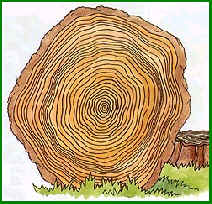Worksheet 1
INSIDE THE TRUNK
When a tree has been blown over or chopped down, have a look at the pattern of rings left on the stump.
They can tell you the whole history of the tree, because each ring represents the layer of wood formed in year of the tree’s life.
1. Count the rings to find out how old the tree was.
2. Look for rings which are particularly wide or narrow. Wide rings shows years when the trees had plenty of rain and grew well. Narrow rings show years of drought or cold weather when the tree grew only a little.
3. If the rings are closer together on one side than the other , try to work out why the tree grew less on the crowed side. Is there a wall or another tree close by?
 |
To Do |
| Can you tell
how old this tree was ?
Can you tell anything else about the tree?
|
HOW OLD IS THAT TREE
You do not have to cut down a tree to estimate its age. You can work it out from its girth-the distance round the trunk. Choose a tree that is growing freely on open ground.
Measure the girth about 1.5 m above the ground. On average a tree adds 2.5 cm to its girth every year.
Divide the result by 5 and then multiply by to get the age of the tree.
Girth divided by 5 multiplied by 2 = age.
If the tree is growing close to a house or in a thick wood it will grow more slowly than an open ground. A tree growing in very cramped conditions may be twice as old as calculated.
To Do
On Trail 1
Calculate the age of the poplar trees at stop 15
Why do you think there is a difference in height between the trees?
Can you tell how old this tree was ?
Can you tell anything else about the tree?
